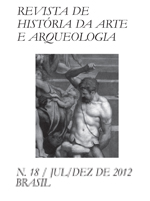Abstract
This paper aims to present the possible use of computer simulations in archeology by building and testing virtual models and the proposed development of autonomous systems of knowledge.. In this way, I present the Lavras do Abade case study where an
electronic model of the site was used to analyze and interpret built space.
References
BINFORD, Sally R., and Lewis BINFORD. New Perspectives in Archaeology. Chicago: Aldine Press, 1968.
BUCHANAN, Fuce G., and Reid G. SMITH. “Fundamentals of Expert System.” Ann. Rev. CompUi. Sci. (1988). GARDIN, Jean-Claude. Artificial Intelligence and expert systems: cases studies in the knowledge domain of archaeolog y. Chichester: Ellis Horwood Limited, 1988.
BUCHANAN, Mark. The Social Atom: Why the Rich Get Richer, Cheaters Get Caught, and Your Neighbor Usually Looks Like You. New York: Bloomsbury Publishing PLC, 2007.
CLARKE, D. L. Analytical Archaeolog y. London: Methuen, 1968. CLARKE, D. L. Models in Archaeolog y. London: Methuen, 1972.
COSTOPOULOS, A., and M. W. LAKE. Simulating Change: Archaeolog y Into the Twenty-First Century. Salt Lake City: University of Utah Press, 2010.
DORAN, J. E. “Iruba: An Agent-Based Model of the Guerrilla War Process.” In ESSA Conference. Koblenz: PreProceedings, 2005.
DORAN, J. E. “Prospects for Agent-Based Modelling in Archaeology.” Archeologia e Calcolatori, 10 (1999): 33-44. 7 DORAN, J. E. “Systems theory, computer simulations and archaeology.” World Archaeolog y 1 (1970): 289-298.
DURKHEIM, Émile. As Regras do Método Sociológico. São Paulo: Martin Claret, 2008, pp. 31-40.
DYKE, Bennett. “Computer Simulation in Anthropology.” Annual Review of Anthropolog y 10 (1981): 193-207.
GARDIN, Jean-Claude. Artificial Intelligence and expert systems: cases studies in the knowledge domain of archaeolog y. Chichester: Ellis Horwood Limited, 1988.
GILBERT, Nigel, and Klaus G. TROITZSCH. Simulation for the Social Scientist. Second Edition ed. Berkshire: Open University Press, 2005.
GILBERT, Nigel. “Agent-based social simulation: dealing with complexity.” Guildford: Centre for Research on Social Simulation – University of Surrey, 2004.
HODDER, I. Simulation Studies in Archaeolog y. Cambridge: Cambridge University Press, 1977. SABLOFF, J.A. Simulations in archaeolog y. Albuquerque: University of New Mexico Press, 1981.
LANSING, J. Stephen. Priests and Programmers: Technologies of Power in the Engineered Landscape of Bali. Princeton: Princeton University Press, 1991.
MCGUIRE, Randall H., and Paul RECKNER. “Building a working class archaeology: the Colorado coal field war project.” Industrial Archaeolog y Review XXV, n. 2 (2003): 83-95.
MORIN, Edgar. Introdução ao pensamento complexo. Translated by Eliane Lisboa. Porto Alegre: Sulina, 2006.
SOBRINHO, Jalmiro R. “Relatório – VLS 0004.” São Paulo: Alezi Teodolini – Hezolinem, 2005.
WALDROP, Mitchell M. Complexity: the Emerging Science at the Edge of Order and Chaos. New York: Touchstone, 1992. BENTLEY, R.A., and H.D.G. MASCHNER. “Complexity Theory.” In: Handbook of Archaeological Theories, edited by RA Bentley, HDG Maschner and C. Chippendale, 245-270: AltaMira Press, 2007

This work is licensed under a Creative Commons Attribution 4.0 International License.
Copyright (c) 2021 Journal of Art History and Culture

